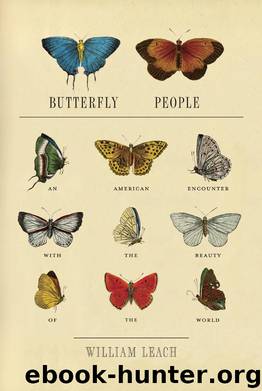Butterfly People by William R. Leach

Author:William R. Leach
Language: eng
Format: mobi, epub
ISBN: 9780307907875
Publisher: Knopf Doubleday Publishing Group
Published: 2013-04-08T21:00:00+00:00
Ernst Hartert at the foot of the Gunong Ijau river, Perak, Malaysia, shortly before meeting Will Doherty in the Perak Museum. From Ernst Hartert, Aus den Wanderjahren eines Naturforschers (Berlin: R. Friedlander, 1901–2).
On the first day of their meeting Hartert borrowed and soiled one of Doherty’s best suits and consumed all his stationery. “He is the most exigent fellow I ever saw.”105 Yet, famished for friendship, Doherty proposed, almost on the spot, that they collect together in northern India near Tibet. Hartert agreed, aware that German naturalists admired Doherty’s work on butterfly classification, and at the end of July, the two took a steamer through the Bay of Bengal to Calcutta, with, in their tow, thirty-six suitcases, a cook, and a servant.106 They boarded an English rail train, fitted with a luxury dining room car, that crossed the rushing immensity of the Ganges River and veered north toward the Himalayas.107 Once in camp, in the same tent—Doherty never shared a tent with any other man—they talked in German and English about science, philosophy, and politics, disagreeing seldom except about Kaiser Wilhelm, to Doherty a “ridiculous figure.”108 Hartert considered Doherty “no ordinary man,” “thoroughly educated … to an astonishing degree,” and “an instructive talker on almost any subject.”109 Near the Dikrang River just north of Sadiya, Hartert collected specimens of “a new Apatura species” and a small chrysalis that pupated into “a beautiful Poritia” butterfly, later described and named by Doherty as Poritia hartertii. Near Margarita, the two men caught many male skippers, the scents of which Doherty could identify, “half vanilla, half heliotrope, as they flew over our heads.” They studied mimicry in the jungles and also on the wall of their dining tent, where Doherty spotted a piece of bird dung (“Voegelschmutz”) that turned out to be a noctuid moth.110
In November 1888, Hartert’s military leave ended, and he returned to Germany to marry. Doherty was devastated. “Since he left me I am intolerably lonely,” he wrote his mother. “How I managed to exist before I met him I don’t know at all, nor how long I shall manage to exist without him. I don’t want much society—he was quite enough, a solitude à deux is quite lively enough for me, but I really can’t stand being by myself much longer. There is no hope of our meeting again.” (He was wrong here; they would meet again under quite different circumstances.) Hartert’s companionship reminded Doherty how crucial it was “to want somebody for my very own as it were, who shall regard all other people about us as outsiders.” “Hartert and I got as far as that,” he wrote. “We were a great comfort to each other and both were quite aware of the fact.”111
Over the next eight years, Doherty worked his way doggedly through Malaysia, collecting for well-heeled Westerners. He returned to America twice to recover his health and to find “some lovely girl” to marry. He wanted one who had “conceived a romantic affection for me upon reading
Download
This site does not store any files on its server. We only index and link to content provided by other sites. Please contact the content providers to delete copyright contents if any and email us, we'll remove relevant links or contents immediately.
Enlightenment Now: The Case for Reason, Science, Humanism, and Progress by Steven Pinker(6871)
A Journey Through Charms and Defence Against the Dark Arts (Harry Potter: A Journey Through…) by Pottermore Publishing(4725)
The Immortal Life of Henrietta Lacks by Rebecca Skloot(4255)
A Journey Through Divination and Astronomy by Publishing Pottermore(4249)
Elon Musk by Ashlee Vance(3854)
Origin Story: A Big History of Everything by David Christian(3472)
COSMOS by Carl Sagan(3346)
Alchemy and Alchemists by C. J. S. Thompson(3294)
Enlightenment Now by Steven Pinker(3271)
Shadow of Night by Deborah Harkness(3173)
Inferior by Angela Saini(3150)
A Mind For Numbers: How to Excel at Math and Science (Even If You Flunked Algebra) by Barbara Oakley(3103)
Bad Pharma by Ben Goldacre(3095)
Origin Story by David Christian(2991)
Signature in the Cell: DNA and the Evidence for Intelligent Design by Stephen C. Meyer(2875)
The Code Book by Simon Singh(2856)
The Elements by Theodore Gray(2851)
A Brief History of Time by Stephen Hawking(2819)
A Journey Through Potions and Herbology (A Journey Through…) by Pottermore Publishing(2772)
